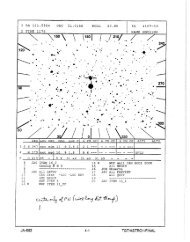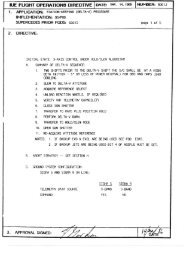The FUSE Archival Data Handbook - MAST - STScI
The FUSE Archival Data Handbook - MAST - STScI
The FUSE Archival Data Handbook - MAST - STScI
Create successful ePaper yourself
Turn your PDF publications into a flip-book with our unique Google optimized e-Paper software.
one SiC channel, each producing a spectrum which falls onto a single detector. Each channel<br />
has a bandpass of about 200 ˚A. Thus, at least two channels are required to cover the ∼290 ˚A<br />
wavelength range of the instrument.<br />
Figure 2.1 also shows the orientation of the instrument prime coordinate system (X,Y ,Z).<br />
<strong>The</strong> two LiF channels are on the +X side of the instrument, which is always kept in the shade<br />
(i.e., the −X side was always facing toward the sun). This orientation minimizes the amount<br />
of sunlight that can make its way down the baffles surrounding the LiF channels. Minimizing<br />
stray light in the LiF channels was crucial to the operation of the Fine Error Sensor (FES)<br />
guidance camera, which operated at visible wavelengths (see Chapter 5). <strong>The</strong> orientation of<br />
the satellite was biased by several degrees in roll around the Z axis in order to keep the radiator<br />
of the operational FES in the shade.<br />
2.2.1 Focal Plane Assemblies<br />
Each telescope focused on an FPA that served as the entrance aperture for its spectrograph. An<br />
FPA was a flat mirror mounted on a two-axis adjustable stage which contained three apertures.<br />
<strong>The</strong> apertures were not shuttered, so whatever light fell on them was dispersed by the gratings<br />
and focused onto the detectors.<br />
<strong>The</strong> orientation of the three apertures is depicted in Fig. 2.2, and their properties are summarized<br />
in Table 2.1. <strong>The</strong> HIRS aperture ensured maximum spectral resolution, minimum sky<br />
background and sometimes allowed for spatial discrimination for extended objects or crowded<br />
stellar fields. However, it blocked part of the point spread function, and small, thermally induced<br />
mirror motions often led to the loss of all light from one or more channels during an<br />
observation. <strong>The</strong> MDRS aperture, with stable mirror alignment, provided maximum throughput<br />
and a spectral resolution comparable to the HIRS aperture for a point source with only<br />
slightly more airglow contamination than HIRS. However, it too, was susceptible to thermal<br />
drifts of the separate channels. <strong>The</strong> LWRS aperture was the least sensitive to alignment issues,<br />
but it allowed the largest sky background contamination. Although image motion could degrade<br />
the resolution of LWRS spectra, this was largely corrected by the pipeline processing for<br />
TTAG data. <strong>The</strong> LWRS aperture was also used to observe faint extended objects, producing<br />
a filled-aperture resolution of ∼100 km s −1 . LWRS was the default aperture throughout most<br />
of the mission because of the thermal image motions that occurred on orbit.<br />
In addition, a target could also be placed outside the apertures at the reference point<br />
(RFPT), which did not transmit light. When a target was placed at the RFPT, the three<br />
apertures sampled the background sky nearby.<br />
Each FPA could be moved independently in two directions. Motion tangential to the Rowland<br />
circle, which is roughly in the dispersion direction, and perpendicular to the apertures.<br />
<strong>The</strong>se motions allowed co-alignment of the channels and permitted focal plane splits (FP splits,<br />
see Chapter 7) for high signal-to-noise ratio observations of bright targets. Motion in Z enabled<br />
focusing of the apertures with respect to the mirrors, spectrograph grating, and detector.<br />
4




